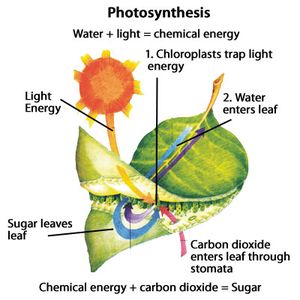30.9.2012 | 16:49
Leitin a endurnřtanlegri orku hjß pl÷ntum
 L÷ngu ßur en hin n˙verandi ßhersla ß 'grŠna orku' ■ß hafa vÝsindamenn veri a vinna a ■vÝ a herma eftir ■vÝ hvernig pl÷ntur fara a ■vÝ a breyta sˇlarljˇsinu Ý eldsneyti. ═ laufum plantna ■ß breytir ljˇstillÝfun koltvÝoxÝ (CO2) og vatni Ý s˙refni og sykur.á HagkvŠmni ■essa orkuflutnings er Ý kringum 97% og er ÷fund verkfrŠinga sem reyna hva ■eir geta a b˙a til gerfi 'ljˇstillÝfun' tŠki.
L÷ngu ßur en hin n˙verandi ßhersla ß 'grŠna orku' ■ß hafa vÝsindamenn veri a vinna a ■vÝ a herma eftir ■vÝ hvernig pl÷ntur fara a ■vÝ a breyta sˇlarljˇsinu Ý eldsneyti. ═ laufum plantna ■ß breytir ljˇstillÝfun koltvÝoxÝ (CO2) og vatni Ý s˙refni og sykur.á HagkvŠmni ■essa orkuflutnings er Ý kringum 97% og er ÷fund verkfrŠinga sem reyna hva ■eir geta a b˙a til gerfi 'ljˇstillÝfun' tŠki.
( veiti ■vÝ athygli a ljˇstillÝfun er ÷ru vÝsi en photovoltaics sem er aferin sem notu er Ý hefbundnum tŠkjum sem sem b˙a til rafmagnsstraum sem er erfitt a geyma )
Kostirnir vi slÝkan pl÷ntuhermi eru mj÷g augljˇsir fyrir ■ß sem rannsaka ■etta: "The production of hydrogen using nothing but water and sunlight offers the possibility of an abundant, renewable, green source of energy for the future,” sagi Tom Mallouk, vi Pennsylvania State hßskˇlann, prˇfessor Ý efnafrŠi og elisfrŠi.
Ůa er samt l÷ng lei til a nß ■essu takmarki. Meira a segja efnafrŠi ■essa flˇkna ferli ljˇstillÝfunnar hefur ekki veri skilin til fulls og hva ■ß hermt eftir!á Vi h÷fum me reglulegu millibili sagt frß frÚttum af uppgv÷tum ß undanf÷rnum ßrum um ■ß snilldarh÷nnun sem pl÷ntu ljˇstillÝfun tŠki og tengdir str˙kt˙rar.á Til dŠmis,á plants have a ‘dimmer switch’, ofur vikvŠman "dimmer" sem breytist eftir ljˇsskilyrum og pl÷ntur einnig "vita" hvenŠr ß a b˙a til sˇlarljˇsv÷rn ■egar skilyrin heimta ■a.
Ein af aal hindrununum eru a leysa rßgßtuna hvernig pl÷ntur geta broti sundir vatns eindina Ý vetni og s˙reefni ßn ■ess a tortřma sjßlfum sÚr Ý leiinni. ( Hugsi bara ˙t Ý Hindenburg slysi ■egar kviknai Ý zeppelÝni og ■ß brann vetnisgasi og var a vatni. Til a brjˇta sundur vatn ■ß ■arf a flytja orkuna sem brřst ■arna fram einhvert. ═ grein sem birtist ßri 1999 Ý New Scientist ■ß var athyglinni beint a ßrangri efnafrŠinganna Gary Brudvig og Robert Crabtree frß Yale en ■eir lřstu vandamßlinu svona:
The oxygen is released by splitting water molecules, a reaction that in the lab requires such violence that it would tear any living system apart. So how can plants do it, using only energy from the sun?
Try breaking water apart in one go and you’d need a huge blast of energy. To do the job with heat alone, for example, you’d need to raise the temperature of water by thousands of degrees—more than enough to vapourise a geranium.
En vi sjßum ekki gras og arar pl÷ntur springa svo augljˇslega hafa pl÷ntur mekanisma sem getur teki Ý sundur vatnseindir Ý vetni og s˙refni vi elilegt hitastig. Brudvig og Crabtree eiga heiurskilinn fyrir a hafa b˙i til kerfi sem getur framleitt s˙refni. En ■eir hafa ekki enn■ß fundi ˙r hvernig hŠgt er a nota ljˇsorkuna, Ý stainn ■ß notuu ■eir Brudvig og Crabtree efnaorkuna ˙r ÷flugum hreinsiefnum. En jafnvel ■ß ■ß gat ■eirra kerfi aeins framleitt 100 s˙refnis sameindir ßur en ■a eyilagist. Eins og Gary Brudvig ˙tskřri:
This is one of the drawbacks of the artificial system. It can’t constantly regenerate itself.
Svo hve miki vitum vi um hvernig pl÷ntur fara a ■essu?á HÚrna er stuttur ˙tdrßttur ˙r grein eftir elisefnafrŠinginn Jonathan Sarfati:
Ingenious solution
It turns out that in leaves there is a special assembly called Photosystem II (named because it was discovered second). A photon strikes this, and it is channeled into a type of chlorophyll called P680. There it knocks out an electron from an atom, and this energetic electron eventually helps make sugars from CO2. But then, the P680 must replenish the lost electron. This is a big problem for artificial photosynthesis— human chemists have also so far been unable to produce a system that replenishes the electrons knocked out by the photons. Photosynthesis would have quickly ground to a halt without this, so how are the electrons replaced?
 Fyrir lesendur sem hafa ßhuga ß efnafrŠi ■ß geta ■eir lesi tŠknilega grein sem ˙tskřrir ■etta, sjß:á Green power (photosynthesis)á En n˙ ■egar b˙i er a gefa bakgrunninn varandi hvaa vandamßl vÝsindamenn standa frammi fyrir ■egar kemur a ■vÝ a b˙a til gerfi ljˇstillÝfunarvÚl ■ß er frŠandi a fß a vita ■a nřjasta sem er a gerast Ý ■essu verkefni frß einum af rannsˇknarm÷nnunum ß ■essu svii, Julian Eaton-Rye.á HÚrna er hvernig ABC vÝsindamaur og ˙tvarpsmaurinn Robyn Williams a kynna Julian Ý vitala nřlega ß "The Science Show" ˙tvarps■Šttinum:
Fyrir lesendur sem hafa ßhuga ß efnafrŠi ■ß geta ■eir lesi tŠknilega grein sem ˙tskřrir ■etta, sjß:á Green power (photosynthesis)á En n˙ ■egar b˙i er a gefa bakgrunninn varandi hvaa vandamßl vÝsindamenn standa frammi fyrir ■egar kemur a ■vÝ a b˙a til gerfi ljˇstillÝfunarvÚl ■ß er frŠandi a fß a vita ■a nřjasta sem er a gerast Ý ■essu verkefni frß einum af rannsˇknarm÷nnunum ß ■essu svii, Julian Eaton-Rye.á HÚrna er hvernig ABC vÝsindamaur og ˙tvarpsmaurinn Robyn Williams a kynna Julian Ý vitala nřlega ß "The Science Show" ˙tvarps■Šttinum:
Robyn Williams: People all over the world are looking for alternative power sources. Professor Julian Eaton-Rye is a biochemist at the University of Otago in Dunedin in New Zealand and he’s interested in adapting photosynthesis to provide power, hydrogen power. He is working on Photosystem II.
Williams and Eaton-Rye then begin their discussion about how Photosystem II is used to break water molecules. Here’s some of the ensuing dialogue after Williams mentions that “it normally happens at normal temperatures.”
Julian Eaton-Rye: It does and I guess that’s the trick of Photosystem II, that it can break water molecules down at ambient temperatures, whereas if you wanted to break water you would have to heat it to about 2,000░C in order to break it down, so you’re not boiling the water, it’s not steam you want, you want to actually decompose the water.
Robyn Williams: So if you weren’t using an electric current, if you just wanted to break it down into hydrogen and oxygen, 2,000░C is a hell of a hot temperature, isn’t it.
Julian Eaton-Rye: Yes, it is. I guess perhaps that’s good for us because it means water is very stable and we need a lot of it and we’ve got a lot of it.
Robyn Williams: And we don’t blow up.
Julian Eaton-Rye: Right, exactly, yes.
Ůa er hßrrÚtt. Vatn er ˇtr˙legt efni sem er akk˙rat rÚtt fyrir lÝfi af ■vÝ a ■a hanna ■annig.á Samt sem ßur, hvorki Williams nÚ Eaton-Rye viurkenndu ■annig h÷nnu Ý stainn fyrir ■a gßfu ■eir heiurinn til ■rˇunarinnar. En eins og mefylgjandi stutta samtal me endalausum tilvÝsunum Ý "arkitekt˙r", "nausynlegt", "vigerir", "h÷nnun", "vikvŠmt", "tŠki", "hagkvŠmni" og "vinnur snuurlaust" ■ß hafa Williams og Eaton-Rye mikla tr˙ a "■rˇun" geri ■etta:
Robyn Williams: And so the secret is presumably an enzyme or more than one enzyme or what?
Julian Eaton-Rye: The secret is a metal centre composed of manganese and calcium, four manganese and one calcium, and they are put together in an architecture and a protein environment that holds them in a certain configuration, which simply allows that to act as the catalyst to drive this reaction. And one of the great challenges is to understand that architecture so that it can be mimicked so that we can make machines that will split water, because we talked about the electrons and the oxygen but of course you also have those protons, and those protons can become hydrogen, and hydrogen is a fuel.
Robyn Williams: And hydrogen would be great to have, but the great thing about enzymes is that when you’ve had the reaction, they are still there at the end, which is nice, isn’t it.
Julian Eaton-Rye: It is nice. In the case of Photosystem II, there’s a slight twist because this is a machine that works at the edge and there’s quite a bit of energy involved from the light that is absorbed, and while that’s splitting water it also causes damage to the actual protein architecture that is essential to hold everything in place to make it work. And what has happened in evolution is that the organisms that house the enzyme have developed a system to constantly repair the photosystem to sustain this reaction, and therefore Photosystem II offers an interesting model to look at how you might design a machine that repairs itself in a chemical way that would sustain this reaction in a synthetic operation.
Robyn Williams: So instead you’ve got a very delicate machine here which can easily break down. In other words, the enzyme can go bust, and you’re trying to see whether there is a way in which you can harness all this and maintain a vigour … the enzyme or something else, so that you don’t have the whole thing break down in about two seconds.
Julian Eaton-Rye: The enzyme doesn’t go bust, and I think that’s its success, is that this machinery that repairs itself is so efficient that the enzyme continues to work seamlessly, and therefore the mechanism involved is a very intriguing one, and if we were able to reproduce it in biomimetic systems then we would be able to have sustained water oxidation panels on our roof that light shines on that continue to make us hydrogen and electrons as a fuel source.
Hugmyndin a svona flˇki kerfi eins og TillÝfunarkerfi II ( svo vi minnumst ekki ß restina af pl÷ntunni me getuna til a fj÷lga sÚr ) gŠti ori til ßn vitrŠnnar h÷nnunar er sannarlega furuleg. Ůa er ekki a undra a RˇmverjabrÚfi 1:20 segir a menn eru "ßn afs÷kunnar" ■egar ■eir segja "■a er enginn Gu" ( Sßlmarnir 14:1, 53:1 )
Eru Julian Eaton-Rye og arir vÝsindamenn ˙t um allan heim eitthva nŠr ■vÝ a geta hermt eftir ljˇstillÝfunarkerfi pl÷ntunnar en ■eir voru fyrir tÝu ßrum sÝan?
Julian Eaton-Rye: That’s perhaps a little bit out there in the future, but the understanding of the chemistry to split water has received a big boost in just the last 12 months with an important X-ray crystal structure of the photosystem from a group in Japan, and there are many people around the world working on the manganese operation. Our own lab works on the protein environment that surrounds that manganese system, and the polypeptides that are necessary to continually turn over the photosystem. I think that the future is promising and the biochemistry is very interesting, and we hope that in the next five to ten years … perhaps just five actually, the real chemistry of the reaction will be understood, and to therefore reproduce it in a sustained way becomes a reasonable goal.
Ef ■a tŠkist einn gˇan veurdag a herma ( nota verkfrŠi ) eftir ■vÝ sem pl÷ntur gera, ■ß mun ■a ekki hafa veri afrakstur tÝma og tilviljanakenndra ferla heldur vitrŠnnar h÷nnunar og vÝsindamennirnir sem bjuggu ■a til munu ßn efa vilja fß heiurinn fyrir ■vÝ afreki.á Hve miklu meiri heiur ß sß ofur gßfai vitrŠni h÷nnuur sem hannai pl÷nturnar upprunalega?!
Ůegar Robyn Williams spuri Julian Eaton-Rye um m÷gulegan grˇa ef a rannsˇknirnar ß ljˇsstillÝfun plantna tŠkjust ■ß svarai Eaton-Rya:
Julian Eaton-Rye: The payoff is clearly that if you can actually make hydrogen from water, you would have solved many, many issues surrounding pollution and sustained energy production. There is no pollution from using water as a source of fuel. So in that sense it’s a very wonderful opportunity that we might be able to pursue.
Leitin a 'pl÷ntu orku': vihaldanleg orkuframleisla frß vatni og sˇlinni sem mengar ekki; hljˇmar eins og snilldar hugmynd! Hver Štli hafi fengi ■essa hugmynd fyrst? :)
Meginflokkur: VÝsindi og frŠi | Aukaflokkar: Heimspeki, Menntun og skˇli, Tr˙mßl | Breytt s.d. kl. 16:52 | Facebook
Um bloggi
Mofa blogg
FŠrsluflokkar
- Bloggar
- Bækur
- Dægurmál
- Ferðalög
- Fjármál
- Fjölmiðlar
- Heilbrigðismál
- Heimspeki
- Íþróttir
- Kjaramál
- Kvikmyndir
- Lífstíll
- Ljóð
- Löggæsla
- Mannréttindi
- Matur og drykkur
- Menning og listir
- Menntun og skóli
- Samgöngur
- Sjónvarp
- Spaugilegt
- Spil og leikir
- Stjórnmál og samfélag
- Sveitarstjórnarkosningar
- Tónlist
- Trúmál
- Trúmál og siðferði
- Tölvur og tækni
- Umhverfismál
- Utanríkismál/alþjóðamál
- Vefurinn
- Viðskipti og fjármál
- Vinir og fjölskylda
- Vísindi og fræði
Tenglar
Kristnar sÝur
Ţmislegt
Sk÷pun/■rˇun
SÝur sem fjalla um sk÷pun/■rˇun
- Detecting Design
- UnCommon descent Blogg sÝa William Dembski um vitrŠna h÷nnun
- Creation-Evolution Headlines SÝa sem fjallar um frÚttir tengdar sk÷pun ■rˇun
- EvolutionNews SÝa sem fjallar um frÚttir sem tengjast Vitsmunah÷nnun
Bloggvinir
- Bergur Thorberg
- Birgirsm
- Brosveitan - Pétur Reynisson
- Bryndís Böðvarsdóttir
- Daníel Þór Þorgrímsson
- Davíð S. Sigurðsson
- Davíð Örn Sveinbjörnsson
- Daði Einarsson
- Dóra litla
- Eva
- Eygló Hjaltalín
- Friðrik Páll Friðriksson
- Georg P Sveinbjörnsson
- Gladius
- Gunnar Ingi Gunnarsson
- Gunnlaugur Halldór Halldórsson
- Guðni Már Henningsson
- Guðrún Sæmundsdóttir
- Guðsteinn Haukur Barkarson
- Gísli Kristjánsson
- Halldóra Hjaltadóttir
- Halldóra Lára Ásgeirsdóttir
- Hjalti Rúnar Ómarsson
- Hörður Finnbogason
- Hörður Halldórsson
- Inga Helgadóttir
- Ingibjörg
- Ingvar Leví Gunnarsson
- Ingvar Valgeirsson
- Janus Hafsteinn Engilbertsson
- Jens Sigurjónsson
- Jóhann Hauksson
- Jóhann Helgason
- Jóhannes Ólafsson Eyfeld
- Jón Hjörleifur Stefánsson
- Jón Ríkharðsson
- Jón Valur Jensson
- Jónatan Gíslason
- Júdas
- Kristin stjórnmálasamtök
- Kristinn Theódórsson
- Kristinn Theódórsson
- Kristinn Ásgrímsson
- Linda
- Mama G
- Morgunstjarnan
- Nonni
- Omnivore
- Predikarinn - Cacoethes scribendi
- Pétur Eyþórsson
- Ragnar Birkir Bjarkarson
- Ragnar Kristján Gestsson
- Ragnar Steinn Ólafsson
- Ragnheiður Katla Laufdal
- Róbert Badí Baldursson
- Rósa Aðalsteinsdóttir
- Rödd í óbyggð, kristilegt félag
- Röddin
- Rúnar Kristjánsson
- Sigurður Þórðarson
- Sigvarður Hans Ísleifsson
- Steinar Immanúel Sörensson
- Styrmir Reynisson
- Svanur Gísli Þorkelsson
- Sverrir Halldórsson
- TARA
- TARA ÓLA/GUÐMUNDSD.
- Theódór Norðkvist
- Tryggvi Hjaltason
- Tímanna Tákn
- Unknown
- Vefritid
- Viðar Freyr Guðmundsson
- gudni.is
- Ólafur Jóhannsson
- Þarfagreinir
- Þórdís Ragnheiður Malmquist
- Alexander Steinarsson Söebech
- Árni Karl Ellertsson
- BookIceland
- Elísa Elíasdóttir
- Fanney Amelía Guðjonsson
- Friðrik Már
- Gestur Halldórsson
- Guðjón E. Hreinberg
- Gunnar Ingvi Hrólfsson
- Gunnar Jóhannesson
- Hulda Þórey Garðarsdóttir
- Jens Guð
- Karl Jóhann Guðnason
- Kristinn Ingi Jónsson
- Lífsréttur
- Mathieu Grettir Skúlason
- Tómas Ibsen Halldórsson
- Valur Arnarson
- Viktor
- Vilhjálmur Örn Vilhjálmsson
Heimsˇknir
Flettingar
- ═ dag (2.7.): 0
- Sl. sˇlarhring: 1
- Sl. viku: 5
- Frß upphafi: 0
Anna
- Innlit Ý dag: 0
- Innlit sl. viku: 5
- Gestir Ý dag: 0
- IP-t÷lur Ý dag: 0
UppfŠrt ß 3 mÝn. fresti.
Skřringar






Athugasemdir
Ůessi grein er ■řing ß ■essari grein hÚrna: In pursuit of plant powerá ╔g afsaka a hafa ekki ■řtt allar tilvitnanirnar, vonandi veldur ■a engum vandrŠum.
Mofi, 30.9.2012 kl. 16:55
BŠta vi athugasemd [Innskrßning]
Ekki er lengur hŠgt a skrifa athugasemdir vi fŠrsluna, ■ar sem tÝmam÷rk ß athugasemdir eru liin.